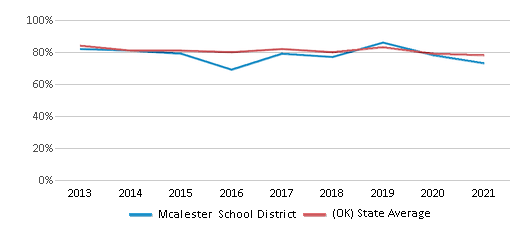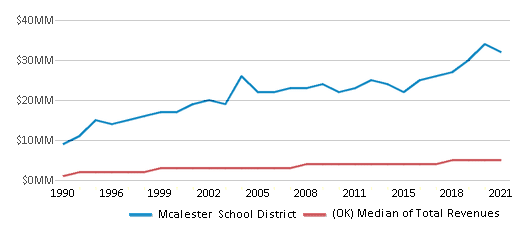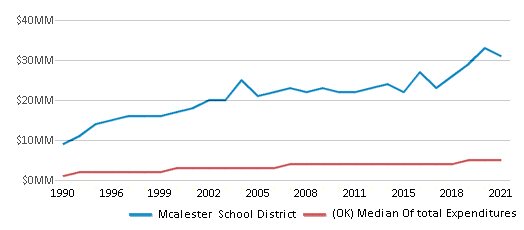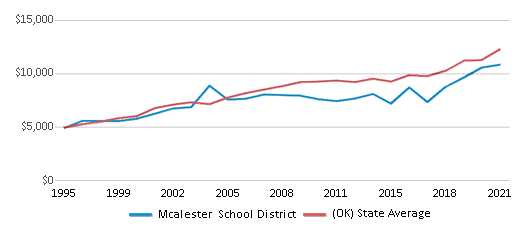Top Rankings
Mcalester School District ranks among the top 20% of public school district in Oklahoma for:
Category
Attribute
Overall Rank
Highest overall rank (Top 20%)
Math Proficiency
Highest math proficiency (Top 20%)
Diversity
Most diverse schools (Top 1%)
Community Size
Largest student body (number of students) (Top 1%)
For the 2025 school year, there is 1 public preschool serving 175 students in Mcalester School District.
Public Preschools in Mcalester School District have a diversity score of 0.74, which is equal to the Oklahoma public preschool average of 0.74.
Minority enrollment is 59% of the student body (majority American Indian and Hispanic), which is more than the Oklahoma public preschool average of 56% (majority Hispanic and American Indian).
Overview
This School District
This State (OK)
# Schools
6 Schools
821 Schools
# Students
2,991 Students
311,633 Students
# Teachers
185 Teachers
19,387 Teachers
Student : Teacher Ratio
16:1
16:1
District Rank
Mcalester School District, which is ranked within the top 20% of all 533 school districts in Oklahoma (based off of combined math and reading proficiency testing data) for the 2021-2022 school year.
The school district's graduation rate of 73% has increased from 69% over five school years.
Overall District Rank
#89 out of 538 school districts
(Top 20%)
(Top 20%)

Math Test Scores (% Proficient)
39%
25%

Reading/Language Arts Test Scores (% Proficient)
32%
27%

Science Test Scores (% Proficient)
38%
31%

Graduation Rate
(20-21)73%
78%

Students by Ethnicity:
Diversity Score
0.72
0.74
# American Indian Students
487 Students
34,190 Students
% American Indian Students
16%
11%
# Asian Students
33 Students
7,116 Students
% Asian Students
1%
2%
# Hispanic Students
444 Students
62,874 Students
% Hispanic Students
15%
20%
# Black Students
101 Students
25,340 Students
% Black Students
4%
8%
# White Students
1,354 Students
135,776 Students
% White Students
45%
44%
# Hawaiian Students
8 Students
1,341 Students
% Hawaiian Students
n/a
1%
# Two or more races Students
564 Students
44,922 Students
% of Two or more races Students
19%
14%
Students by Grade:
# Students in PK Grade:
175
37,955
# Students in K Grade:
182
46,984
# Students in 1st Grade:
171
45,889
# Students in 2nd Grade:
186
44,372
# Students in 3rd Grade:
192
41,579
# Students in 4th Grade:
212
37,550
# Students in 5th Grade:
219
31,634
# Students in 6th Grade:
228
10,304
# Students in 7th Grade:
218
7,534
# Students in 8th Grade:
195
7,832
# Students in 9th Grade:
310
-
# Students in 10th Grade:
250
-
# Students in 11th Grade:
255
-
# Students in 12th Grade:
198
-
# Ungraded Students:
-
-
District Revenue and Spending
The revenue/student of $10,843 in this school district is less than the state median of $10,983. The school district revenue/student has stayed relatively flat over four school years.
The school district's spending/student of $10,498 is less than the state median of $10,957. The school district spending/student has stayed relatively flat over four school years.
Total Revenue
$32 MM
$7,919 MM

Spending
$31 MM
$7,900 MM

Revenue / Student
$10,843
$10,983

Spending / Student
$10,498
$10,957

Best Mcalester School District Public Preschools (2025)
School
(Math and Reading Proficiency)
(Math and Reading Proficiency)
Location
Grades
Students
Rank: n/an/a
301 E Van Buren
Mcalester, OK 74502
(918) 423-6465
Mcalester, OK 74502
(918) 423-6465
Grades: PK
| 175 students
Recent Articles

Year-Round Or Traditional Schedule?
Which is more appropriate for your child? A year-round attendance schedule or traditional schedule? We look at the pros and cons.

Why You Should Encourage Your Child to Join a Sports Team
Participating in team sports has a great many benefits for children, there is no doubt. In this article you will learn what those benefits are.

White Students are Now the Minority in U.S. Public Schools
Increasing birth rates among immigrant families from Asia and Central and South America, combined with lower birth rates among white families, means that for the first time in history, public school students in the United States are majority-minority. This shift in demographics poses difficulties for schools as they work to accommodate children of varying language abilities and socio-economic backgrounds.





